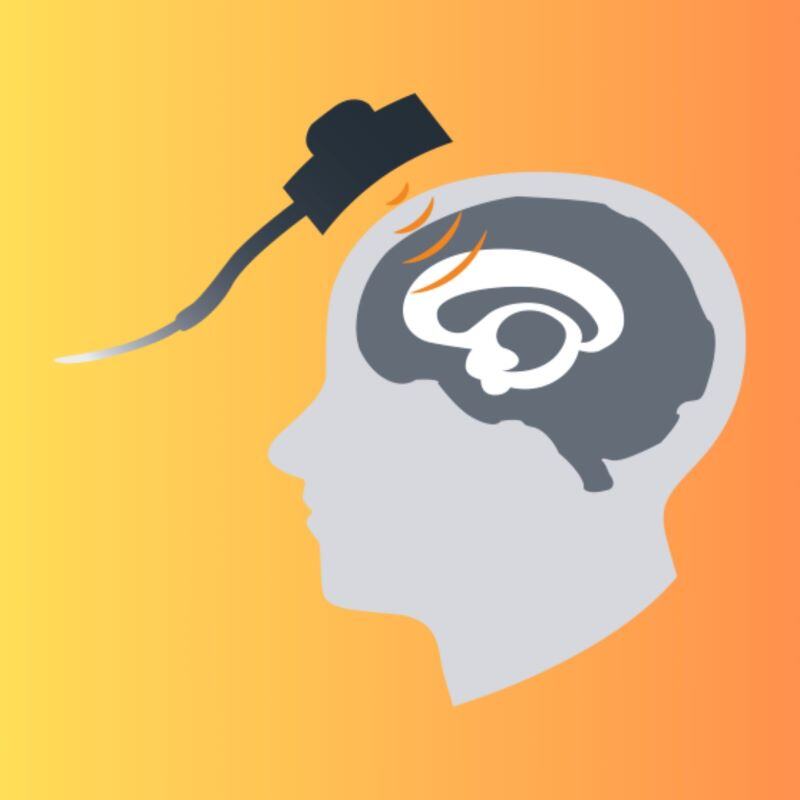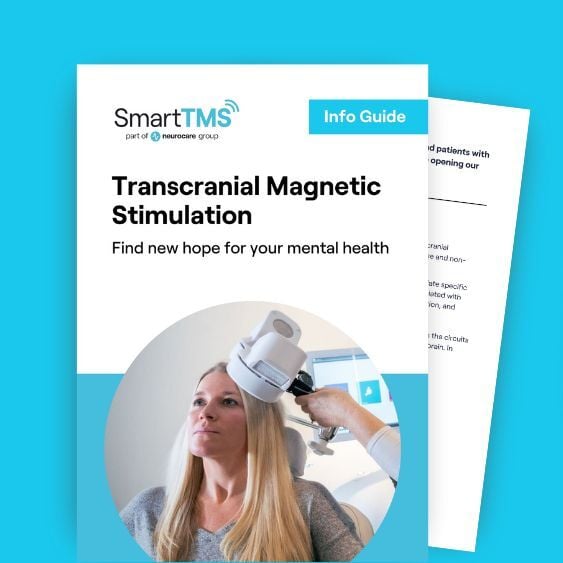‘TMS ruined my life’, Changing Perceptions of Transcranial Magnetic Stimulation
July 25, 2024 - Smart TMS

When reading into Transcranial Magnetic Stimulation (TMS), you might come across articles and blogs containing the phrase “TMS ruined my life” claiming that TMS made their situation worse. These claims can be concerning, but it’s essential to understand the full context and the overwhelmingly positive impact TMS has had on many individuals. TMS is often very effective for treating depression when antidepressants don’t help and it usually has few or no side effects, however it doesn’t work for everyone. Not responding to TMS may indeed lead to negative feelings and experiences, negative experiences with TMS are uncommon, and it’s crucial to understand that just because someone else had a negative experience, it doesn’t mean you will too!
What is TMS?
Transcranial Magnetic Stimulation (TMS) is a non-invasive neuromodulation treatment used primarily for treatment-resistant mental health conditions. It works by using magnetic fields to stimulate nerve cells in the brain. During a TMS session, an electromagnetic coil is placed against the scalp on the necessary treatment point. The coil generates magnetic pulses that pass through the skull and induce electrical currents in specific regions of the brain, particularly those involved in mood regulation.
The mechanisms behind TMS involve modulating neuronal activity. The magnetic pulses can either increase or decrease brain activity in targeted areas. For example, in treating depression, TMS typically targets the left prefrontal cortex, a region that often shows reduced activity in individuals with depression. By stimulating this area, TMS can enhance neuronal activity and connectivity, which is believed to improve mood and alleviate depressive symptoms.
TMS is considered safe and is generally well-tolerated, with the most common side effects being mild scalp discomfort and muscle twitching during treatment. It offers a promising alternative for individuals who have not responded to traditional antidepressant medications and/or talk therapies.
Can TMS make your symptoms worse?
Recent research indicates that while Transcranial Magnetic Stimulation (TMS) is generally safe and effective for treating depression and certain anxiety disorders, it can occasionally lead to an increase in anxiety symptoms, particularly when used for depression. For instance, studies have documented cases where repetitive TMS (rTMS) caused heightened anxiety levels in individuals with panic disorder (Diefenbach et al., 2016). However, these instances are rare. Most clinical studies have shown that TMS does not typically worsen anxiety symptoms and is well-tolerated by most patients (Cohen et al., 2010; George et al., 2010). Moreover, there is no substantial evidence suggesting that TMS exacerbates anxiety for the majority of patients. The temporary worsening of symptoms, often referred to as the “TMS dip,” can occur midway through the treatment but typically subsides as treatment progresses (O’Reardon et al., 2007; George et al., 2010). However, there is no evidence to suggest that TMS can in fact make depression worse in individuals whose conditions were correctly diagnosed.
Furthermore, evidence shows that adverse effects like mania or seizures are extremely rare, and the most common side effects, such as headaches and light-headedness, are usually mild and temporary (O’Reardon et al., 2007). In summary, while there is a small risk of exacerbating anxiety, the benefits of TMS for many patients outweigh the potential for negative outcomes.
The “TMS” Dip
Most patients undergo TMS treatment with minimal to no side effects. However, approximately 20% of patients experience a “TMS dip” around the second or third week of treatment, characterized by a temporary worsening of depression or anxiety symptoms (Daskalakis et al., 2002; Shah et al., 2015). This dip may be due to the brain’s adjustments to the changes induced by TMS. The magnetic pulses stimulate underactive neurons, increasing neurotransmitter release and altering neuronal connections, essentially causing a “reset” in brain communication pathways (Pollak et al., 2014).
Generally, patients begin to feel an improvement three to four weeks after the dip (Daskalakis et al., 2002). Similar to TMS, other depression treatments like antidepressants can also cause an initial dip. Patients often experience a temporary worsening of symptoms and side effects before seeing improvements, which is why doctors recommend continuing antidepressants for 6 to 8 weeks to fully assess their effectiveness (Peterson et al., 2018).
Non-respondents
Responses to treatments vary significantly among individuals. Treating mental health difficulties often requires a long-term approach, involving different therapies to determine the most effective one for each person. Individuals with treatment-resistant conditions may not respond to medication, making it challenging to find the right treatment. Some patients may need a second round of TMS, maintenance sessions, or a combination of TMS and another treatment option, such as an antidepressant, or another holistic approach.
Key Takeaway
Extensive research has shown that TMS is a safe and highly effective treatment for a range of mental health conditions, including depression, anxiety disorders, OCD, and PTSD (Daskalakis et al., 2002; Shah et al., 2015; George et al., 2000). During TMS treatment, patients have regular check-ins with their clinician to monitor progress and make necessary adjustments, ensuring the best outcomes.
While a few individuals may report negative experiences with TMS, these instances are rare. It’s important to base your decision on the broad evidence from numerous clinical studies, which overwhelmingly indicate that TMS is likely to benefit most patients. By choosing TMS, you are opting for a treatment backed by solid scientific research and proven success.
Written by Weronika, Smart TMS Edinburgh practitioner
References:
- Cohen, H., Kaplan, Z., Kotler, M., Kouperman, I., Moisa, R., & Grisaru, N. (2010). Repetitive transcranial magnetic stimulation of the right dorsolateral prefrontal cortex in posttraumatic stress disorder: a double-blind, placebo-controlled study. American Journal of Psychiatry, 161(3), 515-524. Link
- Daskalakis, Z.J., Christensen, B.K., Fitzgerald, P.B., Chen, R. (2002). Transcranial magnetic stimulation: a new investigational and treatment tool in psychiatry. Journal of Neuropsychiatry and Clinical Neurosciences, 14(4), 406-415.
- Diefenbach, G. J., Bragdon, L. B., Goethe, J. W., & Hollifield, M. A. (2016). Transcranial magnetic stimulation for depression and anxiety: The state of the evidence. Psychiatric Clinics, 39(1), 47-59. Link
- George, M. S., Taylor, J. J., & Short, E. B. (2010). The expanding evidence base for rTMS treatment of depression. Current Opinion in Psychiatry, 26(1), 13-18. Link
- O’Reardon, J. P., Solvason, H. B., Janicak, P. G., Sampson, S., Isenberg, K. E., Nahas, Z., … & Sackeim, H. A. (2007). Efficacy and safety of transcranial magnetic stimulation in the acute treatment of major depression: a multisite randomized controlled trial. Biological Psychiatry, 62(11), 1208-1216.
- Peterson, K.T., Kosior, R., Meek, B.P., Ng, M., Perez, D.L., Modirrousta, M. (2018). Right temporoparietal junction transcranial magnetic stimulation in the treatment of psychogenic nonepileptic seizures: a case series. Psychosomatics, 59(6), 601-606.
- Pollak, T.A., Nicholson, T.R., Edwards, M.J., David, A.S. (2014). A systematic review of transcranial magnetic stimulation in the treatment of functional (conversion) neurological symptoms. Journal of Neurology, Neurosurgery, and Psychiatry, 85(2), 191-197.
- Shah, B.B., Chen, R., Zurowski, M., Kalia, L.V., Gunraj, C., Lang, A.E. (2015). Repetitive transcranial magnetic stimulation plus standardized suggestion of benefit for functional movement disorders: an open label case series. Parkinsonism & Related Disorders, 21(4), 407-412
- Trevizol, A. P., Downar, J., Vila-Rodriguez, F., Konstantinou, G., Daskalakis, Z. J., & Blumberger, D. M. Effect of repetitive transcranial magnetic stimulation on anxiety symptoms in patients with major depression: An analysis from the THREE-D trial. Depression and Anxiety. 2021;38(3), 262-271.










